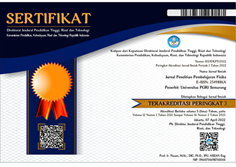Jasmine Flower Classification with CNN Architectures: A Comparative Study of NasNetMobile, VGG16, and Xception in Agricultural Technology
DOI:
https://doi.org/10.26877/asset.v6i4.790Keywords:
jasmine flower, transfer learning, plant classification, CNN, AI in agricultureAbstract
Jasmine flowers have many benefits and uses such as for traditional medicine, tea, perfume, cosmetics, decoration, and others. in the selection of fresh jasmine flowers for making tea is very important, currently the classification of jasmine flowers for making tea is mostly still using manual methods. Often influenced by individual preferences, opinions, or biases. this causes a lack of objectivity and uncertainty in the classification of jasmine flowers. The manual method is very weak due to human visual limitations and fatigue levels which can result in less than the optimal jasmine flower classification. Therefore, in the research that has been done, a transfer learning system was applied that can classify fresh jasmine flowers with rotten jasmine flowers. This study aims to compare three different Convolutional Neural Network architectures: NasNetMobile, VGG16, and Xception. The results on the three architectures can show maximum results, namely 99.21% for NasNetMobile, 98.69% for VGG16 and 97.91% for Xception. This study provides insight into the classification of good and bad jasmine flowers to encourage further exploration in the field of agriculture.
References
L. Gustira Annisa, T. Akbar, and P. Studi Kriya Seni Fakultas Seni Rupa dan Desain, “Bunga Melati Sebagai Motif Pada Baju Kuruang Basiba,” Style J. Fash. Des., vol. II, no. Ii, pp. 68–76, 2023, doi: DOI:10.26887/style.v2i2.3740.
F. N. Hikmah, S. Malahayati, and D. F. Nugraha, “Formulasi Dan Evaluasi Sediaan Serum Gel Ekstrak Bunga Melati (Jasminum sambac L.),” J. Pharm. Care Sci., vol. 3, no. 2, pp. 93–108, 2023, doi: 10.33859/jpcs.v3i2.248.
R. Setyowati, “Aktivitas Antioksidan Teh Herbal Kombinasi Daun Alpukat (Parsea americana Mill.), Daun Teh (Camelia sinnesis) dan Bunga Melati (Jasminum sambac L.) dengan Metode DPPH,” J. Formil (Forum Ilmiah) KesMas Respati, vol. 9, no. 2, pp. 132–147, 2022, doi: https://doi.org/10.35842/formil.v9i2.550.
M. Rafid, A. Luthfiarta, M. Naufal, M. D. Al Fahreza, and M. Indrawan, “The Effect of LAB Color Space with NASNetMobile Fine-tuning on Model Performance for Crowd Detection,” Adv. Sustain. Sci. Eng. Technol., vol. 6, no. 1, p. 02401014, 2024, doi: 10.26877/asset.v6i1.17821.
A. N. R. Munandar and A. F. Rozi, “Analisis Arsitektur Convolutional Neural Network Untuk Klasifikasi Citra Bunga,” J. Teknol. Dan Sist. Inf. Bisnis, vol. 6, no. 3, pp. 522–531, 2024, doi: 10.47233/jteksis.v6i3.1413.
I. P. Kamila, C. A. Sari, E. H. Rachmawanto, and N. R. D. Cahyo, “A Good Evaluation Based on Confusion Matrix for Lung Diseases Classification using Convolutional Neural Networks,” Adv. Sustain. Sci. Eng. Technol., vol. 6, no. 1, p. 0240102, 2023, doi: 10.26877/asset.v6i1.17330.
R. A. Firmansah, H. Santoso, and A. Anwar, “Transfer Learning Implementation on Image Recognition of Indonesian Traditional Houses,” J. Tek. Inform., vol. 4, no. 6, pp. 1469–1478, 2023, doi: 10.52436/1.jutif.2023.4.6.767.
M. M. I. Al-Ghiffary, C. A. Sari, E. H. Rachmawanto, N. M. Yacoob, N. R. D. Cahyo, and R. R. Ali, “Milkfish Freshness Classification Using Convolutional Neural Networks Based on Resnet50 Architecture,” Adv. Sustain. Sci. Eng. Technol., vol. 5, no. 3, p. 0230304, 2023, doi: 10.26877/asset.v5i3.17017.
T. H. Chun, U. R. Hashim, S. Ahmad, L. Salahuddin, N. H. Choon, and K. Kanchymalay, “Efficacy of the Image Augmentation Method using CNN Transfer Learning in Identification of Timber Defect,” Int. J. Adv. Comput. Sci. Appl., vol. 13, no. 5, pp. 107–114, 2022, doi: 10.14569/IJACSA.2022.0130514.
D. Theckedath and R. R. Sedamkar, “Detecting Affect States Using VGG16, ResNet50 and SE-ResNet50 Networks,” SN Comput. Sci., vol. 1, no. 2, pp. 1–7, 2020, doi: 10.1007/s42979-020-0114-9.
Z. P. Jiang, Y. Y. Liu, Z. E. Shao, and K. W. Huang, “An improved VGG16 model for pneumonia image classification,” Appl. Sci., vol. 11, no. 23, 2021, doi: 10.3390/app112311185.
Rismiyati, S. N. Endah, Khadijah, and I. N. Shiddiq, “Xception Architecture Transfer Learning for Garbage Classification,” ICICoS 2020 - Proceeding 4th Int. Conf. Informatics Comput. Sci., 2020, doi: 10.1109/ICICoS51170.2020.9299017.
J. O. Carnagie, A. R. Prabowo, E. P. Budiana, and I. K. Singgih, “Essential Oil Plants Image Classification Using Xception Model,” Procedia Computer Science, vol. 204. pp. 395–402, 2022, doi: 10.1016/j.procs.2022.08.048.
A. M. Alhassan and W. M. N. W. Zainon, “Brain tumor classification in magnetic resonance image using hard swish-based RELU activation function-convolutional neural network,” Neural Comput. Appl., vol. 33, no. 15, pp. 9075–9087, 2021, doi: 10.1007/s00521-020-05671-3.
N. Kadek, D. Adnyaswari, A. Luthfiarta, P. Langgeng, and W. Ellwid, “OPTIMIZING BUTTERFLY CLASSIFICATION THROUGH TRANSFER LEARNING : FINE-TUNING APPROACH WITH NASNETMOBILE AND MOBILENETV2,” J. Tek. Inform., vol. 5, no. 3, pp. 685–692, 2024, doi: https://doi.org/10.52436/1.jutif.2024.5.3.1583.
A. O. Adedoja, P. A. Owolawi, T. Mapayi, and C. Tu, “Intelligent Mobile Plant Disease Diagnostic System Using NASNet-Mobile Deep Learning,” IAENG Int. J. Comput. Sci., vol. 49, no. 1, pp. 216–231, 2022.
D. M. Asriny and R. Jayadi, “Transfer Learning VGG16 for Classification Orange Fruit Images,” J. Syst. Manag. Sci., vol. 13, no. 1, pp. 206–217, 2023, doi: 10.33168/JSMS.2023.0112.
Q. Feng et al., “Online recognition of peanut leaf diseases based on the data balance algorithm and deep transfer learning,” Precis. Agric., vol. 24, no. 2, pp. 560–586, 2023, doi: 10.1007/s11119-022-09959-3.
J. Chen, Y. Cao, and Q. Gu, “Benign Overfitting in Adversarially Robust Linear Classification,” Proc. Mach. Learn. Res., vol. 216, no. Uai, pp. 313–323, 2023, doi: 10.48550/arXiv.2112.15250.
B. Sabiri, B. El Asri, and M. Rhanoui, “Mechanism of Overfitting Avoidance Techniques for Training Deep Neural Networks,” Int. Conf. Enterp. Inf. Syst. ICEIS - Proc., vol. 1, no. May, pp. 418–427, 2022, doi: 10.5220/0011114900003179.











